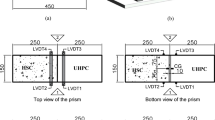Abstract
A disk-shaped compact tension (DC(T)) test has been developed as a practical method for obtaining the fracture energy of asphalt concrete. The main purpose of the development of this specimen geometry is the ability to test cylindrical cores obtained from in-place asphalt concrete pavements or gyratory-compacted specimens fabricated during the mixture design process. A suitable specimen geometry was developed using the ASTM E399 standard for compact tension testing of metals as a starting point. After finalizing the specimen geometry, a typical asphalt concrete surface mixture was tested at various temperatures and loading rates to evaluate the proposed DC(T) configuration. The variability of the fracture energy obtained from the DC(T) geometry was found to be comparable with the variability associated with other fracture tests for asphalt concrete. The ability of the test to detect changes in the fracture energy with the various testing conditions (temperature and loading rate) was the benchmark for determining the potential of using the DC(T) geometry. The test has the capability to capture the transition of asphalt concrete from a brittle material at low temperatures to a more ductile material at higher temperatures. Because testing was conducted on ungrooved specimens, special care was taken to quantify deviations of the crack path from the pure mode I crack path. An analysis of variance of test data revealed that the prototype DC(T) can detect statistical differences in fracture energy resulting for tests conducted across a useful range of test temperatures and loading rates. This specific analysis also indicated that fracture energy is not correlated to crack deviation angle. This paper also provides an overview of ongoing work integrating experimental results and observations with numerical analysis by means of a cohesive zone model tailored for asphalt concrete fracture behavior.
Similar content being viewed by others
References
Superpave Mix Design, Asphalt Institute, Superpave Series No. 2 (SP2), 3rd edition (2001).
Huang, Y.H., Pavement Analysis and Design, Prentice-Hall, Englewood Cliffs, NJ (1993).
Majidzadeh, K., Kauffmann, E.M., andRamsamooj, D.V., “Application of Fracture Mechanics in the Analysis of Pavement Fatigue,”Journal of the Association of Asphalt Paving Technologists,40,227–246 (1971).
Anderson, T.L., Fracture Mechanics: Fundamentals and Applications, CRC Press, Boca Raton, FL (1995).
Kanninen, M.F., andPopelar, C.H., Advanced Fracture Mechanics, Oxford University Press, New York (1985).
Marasteanu, M.O., Labuz, J.F., Dai, S., andLi, X., “Determining the Low-temperature Fracture Toughness of Asphalt Mixtures,”Transportation Research Record 1789,191–199 (2002).
Mobasher, B.M., Mamlouk, M.S., andLin, H-M., “Evaluation of Crack Propagation Properties of Asphalt Mixtures,”ASCE Journal of Transportation Engineering,123 (5),405–413 (1997).
Bhurke, A.S., Shin, E.E., andDrzal, L.T., “Fracture Morphology and Fracture Toughness Measurement of Polymer-modified Asphalt Concrete,”Transportation Research Record 1590,23–33 (1997).
Wagoner, M.P., Buttlar, W.G., and Paulino, G.H., “Development of a Single-edge Notched Beam Test for Asphalt Concrete Mixtures,” ASTM Journal of Testing and Evaluation, in press.
Hofman, R., Oosterbaan, S.M., Erkens, J.G., and van der Kooij, J., “Semi-circular Bending Test to Assess the Resistance Against Crack Growth,” Proceedings of the 6th RILEM Symposium on Performance Testing and Evaluation of Bituminous Materials, Zurich, Switzerland, 257–263 (2003).
Li, X. andMarasteanu, M., “Evaluation of the Low Temperature Fracture Resistance of Asphalt Mixtures using the Semi-circular Bend Test,”Journal of the Association of Asphalt Paving Technologists,73,401–426 (2004).
Jacobs, M.M.J., Hopman, P.C., andMolenaar, A.A.A., “Application of Fracture Mechanics Principles to Analyze Cracking in Asphalt Concrete,”Journal of the Association of Asphalt Paving Technologists,65 1–39 (1996).
ASTM E399-90, “Standard Test Method for Plane-strain Fracture Toughness of Metallic Materials,” Annual Book of ASTM Standards, Vol. 03.01, ASTM International, 443–473 (2002).
Collop, A.C., Sewell, A.J., andThom, N.H., “Laboratory Assessment of the Resistance to Crack Propagation in High Stiffness Asphaltic Materials,”IMechE Journal of Materials: Design and Applications,218(1),55–68 (2004).
Chehab, G.R., O'Quinn, E., andKim, Y.R., “Specimen Geometry Study for Direct Tension Test Based on Mechanical Tests and Air Void Variation in Asphalt Concrete Specimen Compacted by Superpave Gyratory Compactor,”Transportation Research Record 1723,125–132 (2000).
Duan, K., Hu, X-Z., andWittmann, F.H., “Thickness Effect on Fracture Energy of Cementitious Materials,”Cement and Concrete Research 33,499–507 (2003).
AASHTO MP1-93, “Standard Specification for Performance Graded Asphalt Binder,” AASHTO Provisional Standards, 1–4 (1996).
AASHTO TP4-00 “Method for Preparing and Determining the Density of Hot-mix (HMA) Specimen by Means of the Superpave Gyratory Compactor,” AASHTO Provisional Standards, 290–294 (2000).
Olard, F., Di Benedetto, H., Eckmann, B., and Vaniscote, J., “Lowtemperature Failure Behavior of Bituminous Binders and Mixes,” Proceedings of the 83rd Annual Meeting of the Transportation Research Board, Washington, DC (2004).
Miller, R.B. andWichem, D.W., Intermediate Business Statistics: Analysis of Variance, Regression, and Time Series, Dryden Press, Hinsdale, IL (1977).
Paulino, G.H., Song, S.H., and Buttlar, W.G., “Cohesive Zone Modeling of Fracture in Asphalt Concrete,” Proceedings of the 5th RILEM International Conference on Cracking in Pavements, May 5–7, Limoges, France (2004).
Bazant, Z.P., andCedolin, L., Stability of Structures: Elastic Inelastic, Fracture, and Damage Theories, Oxford University Press, New York (1991).
Zhang, Z. andPaulino, G.H., “Cohesive Zone Modeling of Dynamic Failure in Homogeneous and Functionally Graded Materials,”International Journal of Plasticity,21(6),1195–1154 (2005).
Song, S.H., Paulino, G.H., and Buttlar, W.G., “Simulation of Crack Propagation in Aspalt Concrete Using a Cohesive Zone Model,” ASCE Journal of Engineering Mechanics, submitted.
AASHTO TP9-96, “Standard Test Method for Determining the Creep Compliance and Strength of Hot Mix Asphalt (HMA) Using the Indirect Tensile Test Device,” AASHTO Provisional Standards, 169–179 (1991).
Bazant, Z.P. andPlanas, J., Fracture and Size Effect in Concrete and Other Quasi-brittle Materials, CRC Press, Boca Raton, FL (1998).
Author information
Authors and Affiliations
Rights and permissions
About this article
Cite this article
Wagnoner, M.P., Buttlar, W.G. & Paulino, G.H. Disk-shaped compact tension test for asphalt concrete fracture. Experimental Mechanics 45, 270–277 (2005). https://doi.org/10.1007/BF02427951
Received:
Revised:
Issue Date:
DOI: https://doi.org/10.1007/BF02427951




